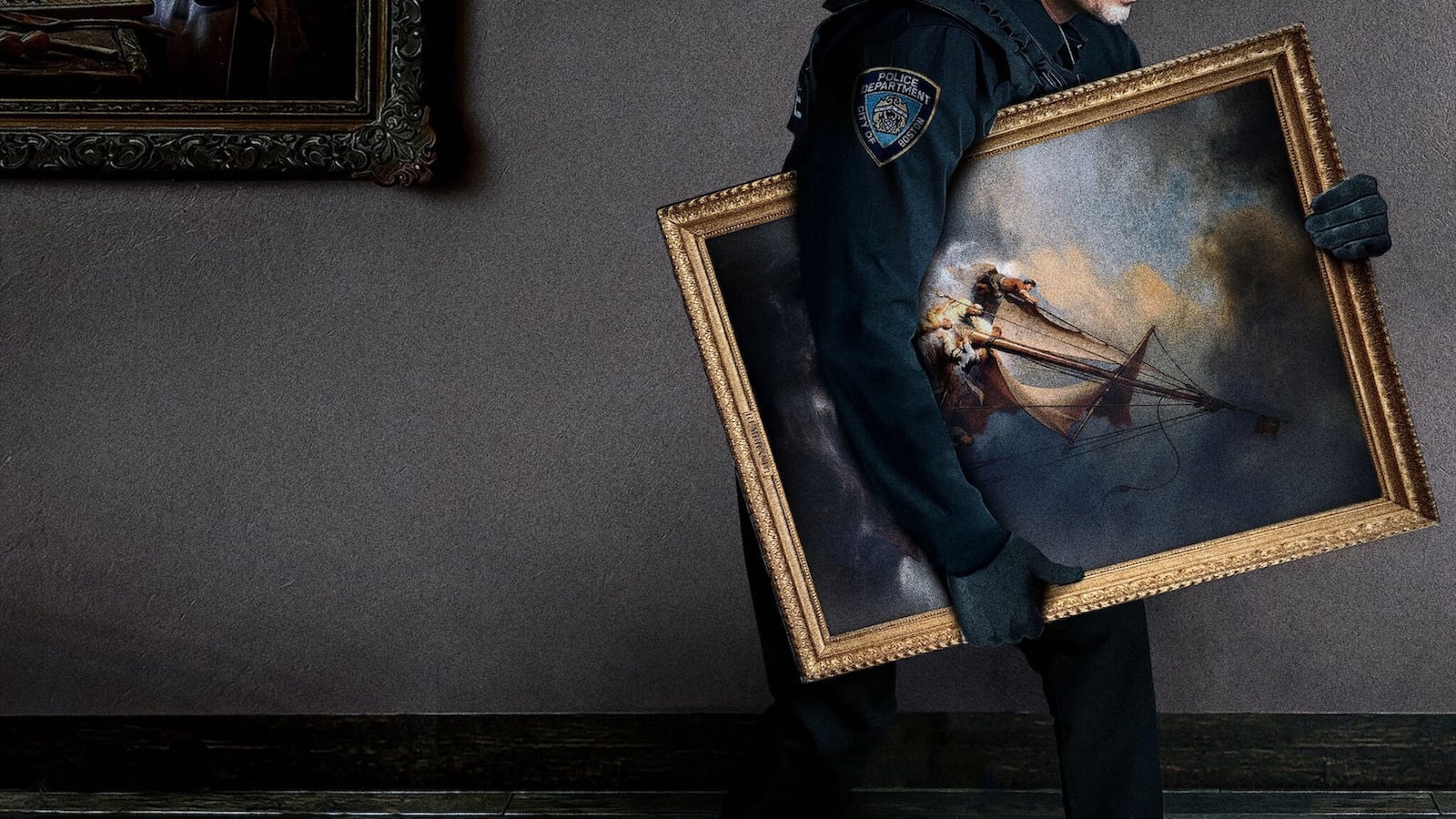On March 18, 1990, two men posing as Boston Police Department officers gained entry into the city’s famed Isabella Stewart Gardner Museum and, after 81 minutes, walked out with 13 works of art—including Rembrandt’s The Storm on the Sea of Galilee and Vermeer’s The Concert—valued by the FBI at approximately $500 million. In the 31 years since that St. Patrick’s Day heist, none of the pieces has been recovered, and none of the individuals responsible for the theft has been definitively identified, or brought to justice. It was one of the crimes of the century, and it continues to confound authorities and journalists to this day.
Yet as suggested by This is a Robbery: The World’s Biggest Art Heist, perhaps the greatest mystery of all isn’t that the crooks initially got away with their loot, but that no one has since squealed—this despite the fact that the museum continues to offer a $10 million reward for information leading to the art’s recovery.
Director Colin Barnicle’s four-part Netflix docuseries (premiering April 7) takes a jaunty look at this infamous heist, which began in the wee hours of March 18, when museum security guard Rick Abath allowed two uniformed strangers into the facility. There, the faux-cops bound Abath and his colleague with duct tape in the basement, and then took their sweet time snatching a strange collection of works from various rooms, as well as grabbing the building’s VHS security camera tapes. There was no apparent rhyme or reason behind the items they targeted, but the patient thoroughness of their activity, as well as their familiarity with the museum—including the location of a secret room’s door—indicated that they may have benefited from inside knowledge or assistance.
Suspicion first fell on Abath, who had previously opened the museum door leading to the street just minutes before the disguised thieves arrived. This is a Robbery spends considerable energy looking into Abath, a stoner-rock slacker by day who didn’t really like his job or his bosses, and who had let someone into the museum—a clear violation of security protocols—the night before the heist. Abath doesn’t participate in the series, but Barnicle does include snippets of a CNN interview with him, as well as an audio recording of his chat with former Boston Globe investigative journalist (and Spotlight team member) Stephen Kurkjian, during which he denies any involvement in the crime.
This is a Robbery has a propulsive momentum that doesn’t interfere with its comprehensive examination of its story’s numerous angles. Utilizing an array of graphical timelines and maps, photographs, and archival news and crime scene videos, it lucidly details the multiple threads that comprise its tale. Interviews with investigators and local journalists help convey the atmosphere of this particular Boston era, while a sense of the Isabella Stewart Gardner Museum comes courtesy of long nocturnal trips through its inviting, ornately decorated hallways. There’s nothing groundbreaking about Barnicle’s chosen form, and his dramatic recreations (shot melodramatically, with actors’ faces always obscured) are a superfluous annoyance. However, thanks to sharp cutting by a team of four editors, the series moves smoothly back and forth in time, and between locales and personalities, to provide a coherent account of the complicated saga.
Though Abath was a promising initial suspect, attention soon turned to Myles Connor, an infamous New England art thief who was as brash as he was talented. The only problem was that Connor had an airtight alibi: he was behind bars for a prior offense when the robbery took place. Nonetheless, thanks to present-day interviews with Connor and others, This is a Robbery surmises that Connor may have had a hand in the burglary via his association with Bobby Donati, an Italian mafioso with whom he’d previously partnered on an art-snatching job. Donati thus had experience with such plots, and moreover, he had a motive—namely, to get his underworld pal Vincent Ferrara out of prison.
It’s there that This is a Robbery dives headfirst into a tangle of Italian mob connections and conspiracies, resulting in a persuasive theory that Donati and his close confidant Bobby Guarente concocted the plan, which was then carried out by a group of gangsters—led by Carmello Merlino, and including Charlie Pappas, David Turner, George Reissfelder, and Leonard Dimuzio—that operated out of Merlino’s TRC Auto Electric shop in Dorchester. Through analysis of these characters’ whereabouts and history, as well as anecdotes from their relatives, Barnicle’s docuseries comes up with a reasonable hypothesis about who pulled off the heist. It additionally deduces that in the aftermath of the crime, the art may have been transferred by Guarente to Hartford, CT gangster Robert Gentile, whose house eventually became the subject of a raid that, alas, turned up no hard evidence.
This is a Robbery is most illuminating when exploring the motivations of thieves who pilfer priceless one-of-a-kind artworks. While sales on the black market are an option, the series reveals that such paintings and sculptures can also be used as collateral for drug deals, thereby functioning as illicit pseudo-currency for big transactions. More stunning still, they’re often sought as leverage against future incarceration. In other words, a thief could theoretically trade a Rembrandt in their possession for a lighter sentence regarding an unrelated case—a “get out of jail free card” situation that Connor himself pioneered. That Guarente, Merlino and company didn’t cough up a painting in order to free their arrested cohorts, then, might mean that they didn’t actually have anything to do with the heist in the first place.
Hovering over these proceedings is the bigger question of why no one has decided to sing and, in doing so, collect the $10 million reward. The answer may simply be that it’s because most of the possible culprits are now dead (due to natural causes, murder or shady circumstances). Or it could be that a bombshell is forthcoming, now that David Turner has been released from prison. This is a Robbery doesn’t offer a definitive answer, instead tantalizing by suggesting that the truth is still out there.


